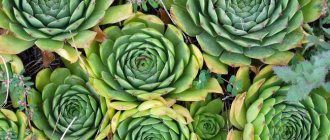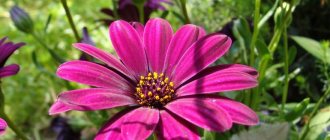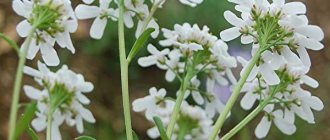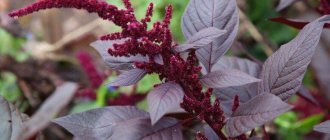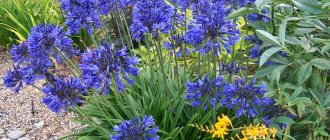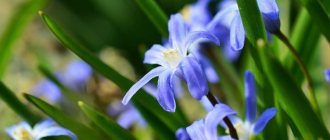Saxifraga, stone rose, hare cabbage, tenacious, crassula, thunderweed - these are all nicknames for one plant! Its main name, rejuvenated , comes from two Latin words that translate as "always alive."
This is an evergreen and beautiful plant. The leaf color is most often green . There are varieties with red leaves or a combined version.
Description: varieties and varieties of young
Anyone who has never seen a young fish, but has heard any of its names, will certainly want to look at this miracle of nature. If not live, then at least in the photo. The plant is surprisingly similar to a rosebud and at the same time to some variety of ornamental cabbage. What else, besides its appearance, distinguishes the young plant - planting and caring for it is suitable even for the laziest.
Stone rose is a favorite crop of landscape designers
It blooms only once, in the summer (most often in the 3rd year of life), but for as long as 2-2.5 months. Otherwise, the “stone rose” pleases the eye with beautiful leaves: oblong, round or long, sometimes pointed. Depending on the variety, they can be green, brown, red, pink and even silver. Some species change color with the seasons. This color palette explains the popularity of using the plant in landscape design.
Now about 50 varieties of juveniles are known:
- Roofing. Its leaves are green with a red border. One of the most famous varieties.
Roofing rejuvenated
- Cobwebby. It is distinguished by tiny rosettes, their diameter is up to 3 cm. It got its name because of the white hairs on the leaves. From a distance they resemble a cobweb.
Cobwebby young
- Marble. Its leaves are red-green with pink tips.
Marble rejuvenated
- Wulfena. It is considered a simple variety with rosettes up to 5 cm. Nevertheless, many gardeners love it for its soft green color.
Young Wulfen
- "Gamma". The young ones bred by breeders had dark brown leaves, etc.
Gamma Rejuvenated
Popular rumor ascribes antidote properties to the “stone rose”. It is also believed that the young one diverts lightning away from the house. That is why its planting on roofs was common (hence the name of one of the varieties). In folk medicine, this plant is used to treat diseases of the gastrointestinal tract, heart, respiratory tract, etc.
Common species of the genus Molodilo
This genus unites many representatives; we suggest focusing on the most popular ones.
Cobweb juvenile or Sempervivum arachnoid (Sempervivum arachnoideum)
The diameter of delicate rosettes is up to 0.075 meters. The leaves are pale green in color with hairy edges.
Sempervivum arachnoideum
Sometimes they seem to be covered with a “cobweb”. It blooms with miniature pink stars. Looks impressive in rock gardens.
Sempervivum Pacific Blue Ice
It is distinguished by an unusual cup-shaped configuration, the rosettes are round in shape.
Sempervivum Pacific Blue Ice
The leaves are icy, blue-green in color with a characteristic pink in the center.
Sempervivum arachnoideum "Viridescens"
A low-growing representative with juicy, fleshy leaves, they are light green in the center. The flowers are pink in color.
Sempervivum Barbulatum
A miniature representative, reaching a height of up to 4 centimeters. The leaves are original ovoid in shape, have woolly tips, and a green tint.
Sempervivum Barbulatum
In summer it gives pleasant pink flowers.
Sempervivum cantabricum
Characterized by succulent, oblong-shaped leaves. They are dark green with a pink ending. The petals of these bushes are red.
Planting a plant
Many people think: since the young plant looks so fancy, planting and caring for it definitely takes a lot of time. And they are wrong. Those who have managed to get acquainted with the plant note its extraordinary unpretentiousness. To grow this perennial in open ground, create the following microclimate:
- place – sunny;
- the soil is better infertile, sandy, well permeable to water.
Juvenile prefers the same soils as cacti.
If these conditions are met, after planting you can practically forget about care. In other circumstances, to reproduce the young on your site, you will need to make a little more effort.
Attention! Juveniles take root less well on heavy, clayey soils; they do not like excess moisture or excess fertilizer.
The plant has a poorly developed root system, so there is no need to make large holes when planting. Make the distance between large rosettes about 15 cm, between miniature ones - 5 cm. After this, watering. If you plant juveniles not in open ground, but in a window, add drainage to the bottom of the pot. You can add sand or sawdust to the soil. The main condition that makes growing juveniles successful is the same - a well-lit place.
Care: the worse the better
Juveniles are extremely unpretentious plants. In nature, they live on sandy and rocky soils, so for a comfortable existence in the garden they need light, loose, well-drained soil, neutral or slightly alkaline (the article How to find out the type of soil and why this is needed will help you determine acidity). Ideally, it should be completely poor, because on fertile soil the young grow too much and weaken, becoming less winter-hardy. Naturally, these plants also do not need watering or fertilizing, with the exception of very hot and dry summers.
And of course, a little watering will be beneficial when planting young plants. But excess moisture can lead to rotting of the leaves and death of the plant. One of the most important conditions for the prosperity of young plants is an open, sunny place. Not only because these plants in the shade of trees may lose their colors, but also because leaf litter will lead to damping off. Therefore, shelters for the winter are also excluded: snow cover is enough for the young ones.
Stone roses are resistant to diseases and pests. The only thing that can cause some trouble in caring for them is weeds. Those that grow in dense curtains are especially unpleasant - they are very inconvenient to remove. Therefore, the soil is carefully prepared before planting, freed from weeds, and then mulched after planting. Gravel, granite screenings, pebbles, expanded clay, and crushed stone are perfect for these purposes.
Text: O. Uvarova. Photo: A. Lysikov, S. Kalyakin, O. Uvarova, shutterstock.com…
Caring for the young
This decorative perennial is very easy to care for. All it needs is freedom from weeds and outdated rosettes, as well as loose soil. Juveniles practically do not require watering. Like all succulents, it stores moisture in its leaves. Approximately every 3-5 years, the “stone rose” needs to be replanted. This is necessary if you see that it is getting smaller.
The young do not need constant supervision. It is enough to water it during dry periods. Attention! In arid climates and poor soils, you cannot forget about watering. It is undesirable for water not to get inside the sockets.
Dampness is contraindicated for the plant - it causes the lower leaves to rot. Make sure that the water in the open ground does not stagnate in the spring, when the snow melts, and in the fall, during periods of heavy rain. You don’t need to cover the young for the winter; it tolerates frost well. But if you propagated a perennial in the fall, make a “blanket” of spruce branches for the young rosettes.
Growing and care
Growing young ones is not a difficult task. These are plants that prefer no care. Caring for young plants in the garden is mainly limited to removing weeds that grow nearby. Left alone, they happily produce flower stalks and delight with colorful, albeit small, flowers without a noticeable odor. After flowering, these tall stems wither and die and can be removed for aesthetic reasons. The growth in width over several months is impressive, so when organizing the planting of young plants in a rocky garden, it is worth taking into account its growth potential.
Watering
To properly care for the young, you must first of all water it correctly. As a plant created for arid conditions, the young require virtually no watering. On wet soils with a tendency to stagnant water, fungal diseases and root rot can quickly occur. Drought is less harmful to these plants than excess water. However, during the period of intensive growth of young rosettes, they should be watered.
Wet winters can cause serious damage to them. Potted plants with proper drainage may require a little watering from time to time, especially in the spring and summer. However, the substrate should never be constantly wet.
What fertilizers are needed?
The question of feeding the young is somewhat different. It will benefit from a dose of slow-release fertilizer applied early in the season in the spring. Or it is enough to feed them with mature compost every 2-3 years. Older plants are better suited to a balanced preparation; younger plants require fertilizer with a lower level of nitrogen. Many gardeners do not fertilize the young plants at all, and get wonderful results.
An overly fertile substrate is even unfavorable - the young will be less contrastingly colored.
Trimming
There is usually no need to prune the young. If necessary, you can remove dead parts of the plant. In this case, it is worth cutting off the faded inflorescences along with the dead part of the rosette.
Reproduction
It is very easy to propagate young - there are several ways:
- growing from seeds;
- dividing sockets;
- rooting of the shoot.
It is easy to propagate juveniles by dividing rosettes - just carefully separate with your hands the rosettes of leaves that appeared last season, and in spring or early summer transplant them to another place, perhaps in pots with a well-drained substrate.
You can also sow young plants with seeds for seedlings. From the blossoming flowers you can collect the seeds of the young. Seeds are subjected to 4-6 weeks of stratification (supercooling), after which they are sown in boxes filled with permeable soil. After sowing in spring in a sandy substrate, the seeds will begin to germinate in 2-6 weeks. To germinate, young seeds need sunlight and a temperature of 20-21 degrees C.
You can also cut off one shoot and leave it in the air to dry. When the wound hardens (after a week), we plant the shoot in slightly damp sand and wait for the plant to grow.
Rejuvenation
Overgrown 3-4 year old clusters of juveniles need to be rejuvenated, they are unsightly “balding” inside. It is better to do this at the beginning of summer, when the young rosettes of this year have already grown and are forming roots. We divide the plants into separate rosettes and bury them in the substrate. For them to develop, a little soil is enough; it must be permeable, with the addition of gravel or coarse sand.
Winter protection
Juveniles, although they look exotic, are the most frost-resistant succulent in the world. The colored rosettes of leaves remain virtually unchanged throughout the winter, but do not produce shoots in winter. Therefore, in the Middle Zone and Moscow region, protection of young plants from frost in the cold months is not necessary, with the exception of potted plants, which are best transferred to a house or greenhouse. As a last resort, it is better to bury containers with plants in the ground before winter or wrap them properly in polystyrene foam.
A dry substrate contributes to a good wintering of the young. Despite their high frost resistance, individual specimens or roofing plants may be subject to physiological drought during a dry, snowless winter. Therefore, it is worth taking care of their shelter, which agrofibre can help with.
Diseases, pests
The biggest problem in growing young ones is the roots becoming soaked, which leads to rot. Therefore, drier conditions are always definitely more favorable.
If the air humidity is high and the temperature is not too high, the juvenile colony may be affected by rust. This leads to progressive deformation of the leaves and the appearance of ugly brown spots. If rust appears, remove the damaged parts of the plant and spray the rest with a fungicide.
Juveniles grown in pots sometimes become victims of mealybugs that remain in dry soil - the only salvation is a complete replacement of the substrate and an appropriate insecticide.
Fertilizer and fertilizing of young
Another fact in favor of the fact that caring for the “stone rose” is simple. Constant fertilization, especially with organic matter, harms the plant. It loses its decorative effect, the leaves may change color. However, when growing juveniles, feeding during the period of active growth is useful. For this purpose, you should use a complex fertilizer for cacti and other succulents.
You can fertilize the plant with cactus fertilizers.
In the spring, when planting begins, you can fertilize with nitrogen. For example, add ammonium nitrate (7-8 g per 1 sq.m.) to the soil. It stimulates the growth of young people. After this, the plant does without fertilizing.
Plant propagation
If you are fascinated by growing young and you want to increase its quantity on your site, there are 2 options:
- sow seeds;
- use subsidiary sockets.
Seeds are sown to a depth of 1 mm. The optimal time is February or March. They are germinated at +20°C. Shoots will appear in 3-5 days. Provide the seedlings with the right conditions and care: a bright place and protection from excessive sun.
If they do not germinate in 4-5 weeks, experts advise refrigerating the pots for 2-4 weeks and repeating the exposure to sun and temperature conditions. In most cases, the seeds will germinate and you will eventually have tiny rosettes. The peculiarity of growing young from seeds is that the plants can have a different shape from the parent, since they tend to hybridize quite easily. But either way, you'll end up with some beautiful and interesting plants, just not the same shape as the parents.
If you want to grow rock rose from your own seeds, you need to collect them correctly. Once the flowers fade, a small, dry, seed-filled fruit is formed. Remove any excess leaves and allow the fruit to dry completely before removing the seeds. Before sowing, stratify the seeds for 4 weeks.
Young plants should be planted in a permanent place in mid-summer.
The seeds were young
Propagation of perennials by seeds is a long process. It is justified if you are going to develop a new variety. In other situations, it is better to choose the second method. For propagation, it is better to separate the “daughters” from the mother’s rosettes in the spring, but it is also possible in the summer. Immediately plant large ones in a permanent place in open ground. Let the small ones grow on the beds before planting.
Bloom
2-3 years after planting, the stone rose blooms. The plant produces a peduncle. This happens in August . Different varieties have different flower colors:
- white.
- yellow,
- pink,
- red.
After flowering, the plant dies , so the age of saxifrage rarely exceeds 3 years. This is compensated by the abundance of children that grow nearby, and therefore the death of the mother plant is often unnoticeable. The peduncle must be removed after flowering if you do not plan to collect the seeds.
Winter is a period of rest for plants, both at home and in nature. At this time of year, saxifrage does not bloom or reproduce .
Diseases and pests
Often when growing young, gardeners are faced with the problem of rot. This disease is typical for plants that are planted in humid climates. It is not difficult to detect: just inspect the lower leaves. If you don’t know how to determine the onset of the disease, study the photo of the young affected by rot.
Plant affected by root rot
Sometimes individual rosettes can suddenly become transparent, then brown. They need to be dug up. Although the rot does not spread to neighboring plants, it does not look aesthetically pleasing, especially in combination with healthy specimens.
More dangerous to the young are the larvae of the cockchafer and birds: jackdaws, jays, magpies, crows. The former spoil the roots of the plant, while the latter feast on the stems. To get rid of the larvae, you can transplant the “stone rose” to a new place, and remove the pests from the ground. In the fight against birds, you should use special preparations or plant plants that repel birds.
Useful properties of rejuvenated roofing
In addition to its decorative properties, this succulent plant is used for other purposes - cooking, traditional medicine. Let us describe what is remarkable about the flower in home use.
Application of Molodil in cooking
The young shoots and fleshy leaves of this succulent are edible raw. They are similar in taste and consistency to cucumbers. Juice is also prepared from the leaves. The fruits are also edible, as are the seeds and other parts of the plant. But in large quantities this plant can cause vomiting, so it is better to eat it in moderation.
Medicinal properties
Because of their cooling and astringent effect, the leaves and their juice are used externally to soothe many skin conditions. It is used as a poultice to treat abscesses, wounds and skin conditions ranging from eczema to ringworm, shingles, nosebleeds and bee and nettle stings. Juvenile can be used for sun or other types of burns. The juice from the leaves was instilled into sore eyes and ears, and also to get rid of warts and corns. Honey mixed with succulent juice helps relieve the pain of mouth ulcers.
In large doses, Molodilo juice was used as a laxative. The plant is also sometimes used internally to treat shingles, skin conditions, and hemorrhoids.
Modern medical research has shown that Molodilo contains carbohydrates, isoazimonic acid, citric acid, malic acid, malonic acid, free amino acids (asparagines), phenolcarboxylic acid and flavonoids.
Young: combination with other plants
The variety of varieties of “stone rose” allows it to be widely used in landscape design. It goes well with other groundcovers: sedum, saxifrage, etc. With their help you can create a beautiful variegated carpet. The combination of different types of juveniles in one area is effective.
Reproduction in the flowerbed
Compositions with bright flowers (for example, phlox) are beautiful. But you should remember one rule. Juveniles do not get along well with lushly flowering plants. They create a shadow that is undesirable for a “stone rose”.
Description
- Juveniles form thick and dense rosettes of fleshy leaves of various shapes up to 15 cm in diameter.
- The rosettes grow into dense curtains that willingly occupy the surrounding free space.
- Each individual rosette of the plant blooms and bears fruit only once in its life, raising a flowering stem up to 20-30 cm in height.
montegon/Flickr.com
Krzysztof Golik / Personal archive
Juveniles are distinguished by a large number of stoloniferous shoots . At the ends of each stolon, children - daughter rosettes . It is due to them that the plant is restored , since after flowering and fruiting the adult rosette gradually dies off .
- The color of leaf rosettes is very diverse. The species diversity of the plant is great, and the varietal variety is even greater.
- Frost resistance zone of stone rose 5, up to – 28.8 ºС.
Hans Braxmeier / Personal archive
Rejuvenation in landscape design
There is probably no better use for young animals than an alpine slide. Very often they decorate rockeries (slides made of stones). It is good to plant this perennial along garden paths. Decorating roofs with rejuvenated roofs, for example, in gazebos, has again become relevant.
Stone rose in landscape design
The plant will be appropriate in flower beds and flowerpots. The main thing that landscape design experts recommend is to complement the composition with stones. They will add integrity and completeness to your idea.
The variety of species of juveniles and its simple care allow even inexperienced summer residents to easily experiment with the design of their site. And what could be more enjoyable than creating beauty with your own hands!
Application of Sempervivum tectorum in garden decoration
This species of the genus Sempervivum is a frequent guest in the gardens of many gardeners. Considering its dwarf size and ease of care, many gardeners decorate their alpine slides, rockeries, dry streams and other stone compositions with Rejuvenate.
Also, “Stone Roses” can be found in various flower beds; they are often used in vertical gardening, excellent for potted flower arrangements. We would like to emphasize once again that this species will be an ideal option for novice gardeners.
